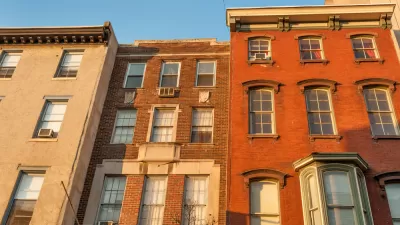City officials in Philadelphia are scrambling to deal with the fallout after a developer suddenly backed out of a deal that allowed additional height in exchange for affordable housing units for a 250-unit development near the Delaware River.
Inga Saffron reports: "A top Philadelphia zoning official said Monday that tenants will not be allowed to move into a luxurious new Delaware waterfront apartment building unless the developer includes 25 affordable units as promised - or offers a suitable alternative, such as ground-floor retail, public art, or a contribution to the city's Housing Trust Fund."
The developer in question, PMC Property Group, had nearly finished the 250-unit One Water Street project "when it asked to be released from an inclusionary housing deal that it cut with the city in 2014," adds Saffron. PMC had promised to build the affordable units in exchange for a 48-foot height bonus. At the time of Saffron's article, the developers had also offered no explanation for the change.
Saffron also includes an account of the fallout from PMC's decision—including outcry on social media and from housing advocates in the city of Philadelphia.

Manufactured Crisis: Losing the Nation’s Largest Source of Unsubsidized Affordable Housing
Manufactured housing communities have long been an affordable housing option for millions of people living in the U.S., but that affordability is disappearing rapidly. How did we get here?

Americans May Be Stuck — But Why?
Americans are moving a lot less than they once did, and that is a problem. While Yoni Applebaum, in his highly-publicized article Stuck, gets the reasons badly wrong, it's still important to ask: why are we moving so much less than before?

Using Old Oil and Gas Wells for Green Energy Storage
Penn State researchers have found that repurposing abandoned oil and gas wells for geothermal-assisted compressed-air energy storage can boost efficiency, reduce environmental risks, and support clean energy and job transitions.

Updating LA’s Tree Rules Could Bring More Shade to Underserved Neighborhoods
A new USC study finds that relaxing Los Angeles’ outdated tree planting guidelines could significantly expand urban tree canopy and reduce shade disparities in lower-income neighborhoods, though infrastructure investments are also needed.

California's Canal Solar Projects Aim to Conserve Resources and Expand Clean Energy
California’s Project Nexus has begun generating electricity from solar panels installed over irrigation canals, with researchers and state agencies exploring statewide expansion to conserve water and boost clean energy production.

HHS Staff Cuts Gut Energy Assistance Program
The full staff of a federal program that distributes heating and cooling assistance for low-income families was laid off, jeopardizing the program’s operations.
Urban Design for Planners 1: Software Tools
This six-course series explores essential urban design concepts using open source software and equips planners with the tools they need to participate fully in the urban design process.
Planning for Universal Design
Learn the tools for implementing Universal Design in planning regulations.
Heyer Gruel & Associates PA
City of Moreno Valley
Institute for Housing and Urban Development Studies (IHS)
City of Grandview
Harvard GSD Executive Education
Salt Lake City
NYU Wagner Graduate School of Public Service
City of Cambridge, Maryland





























